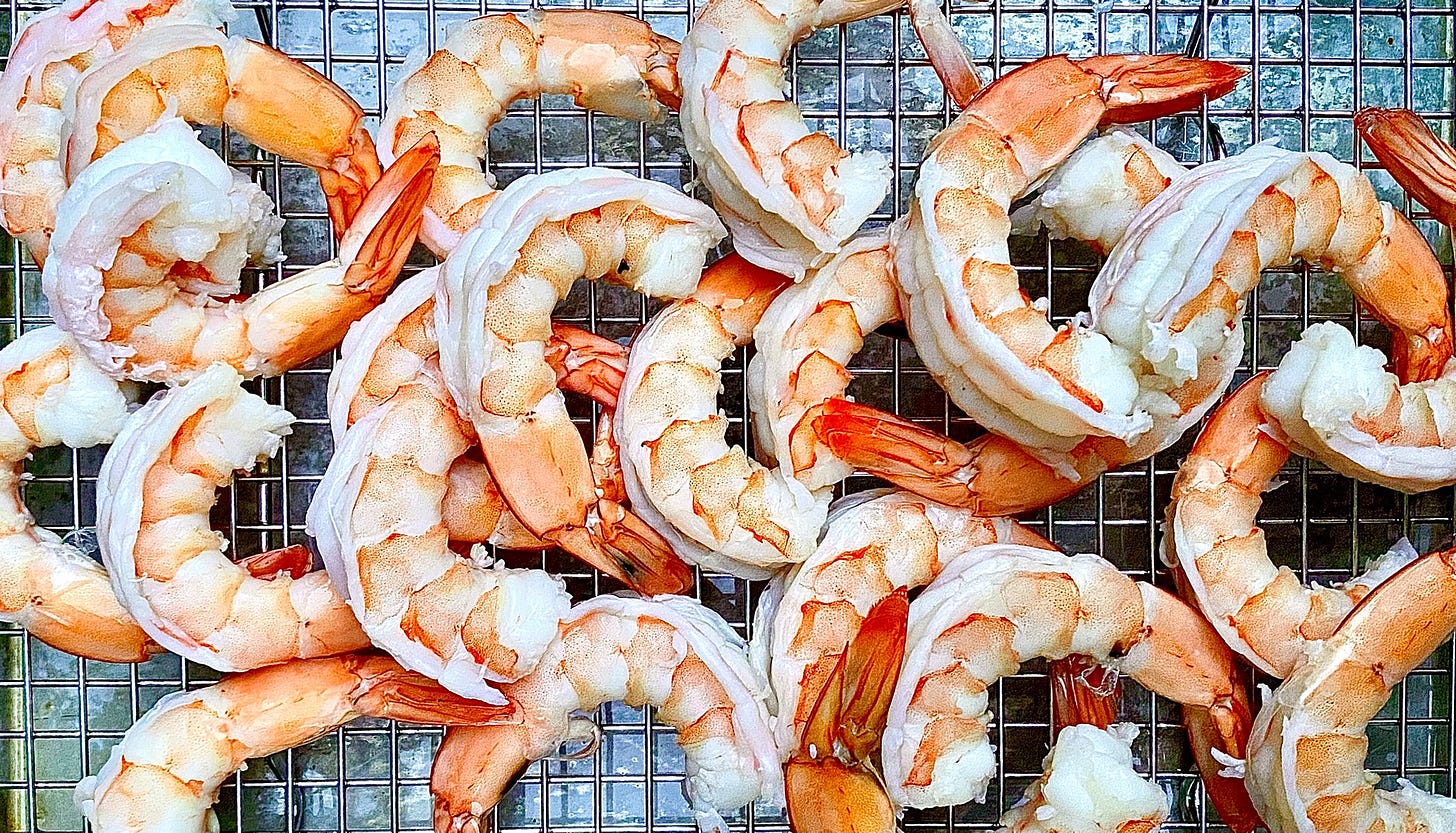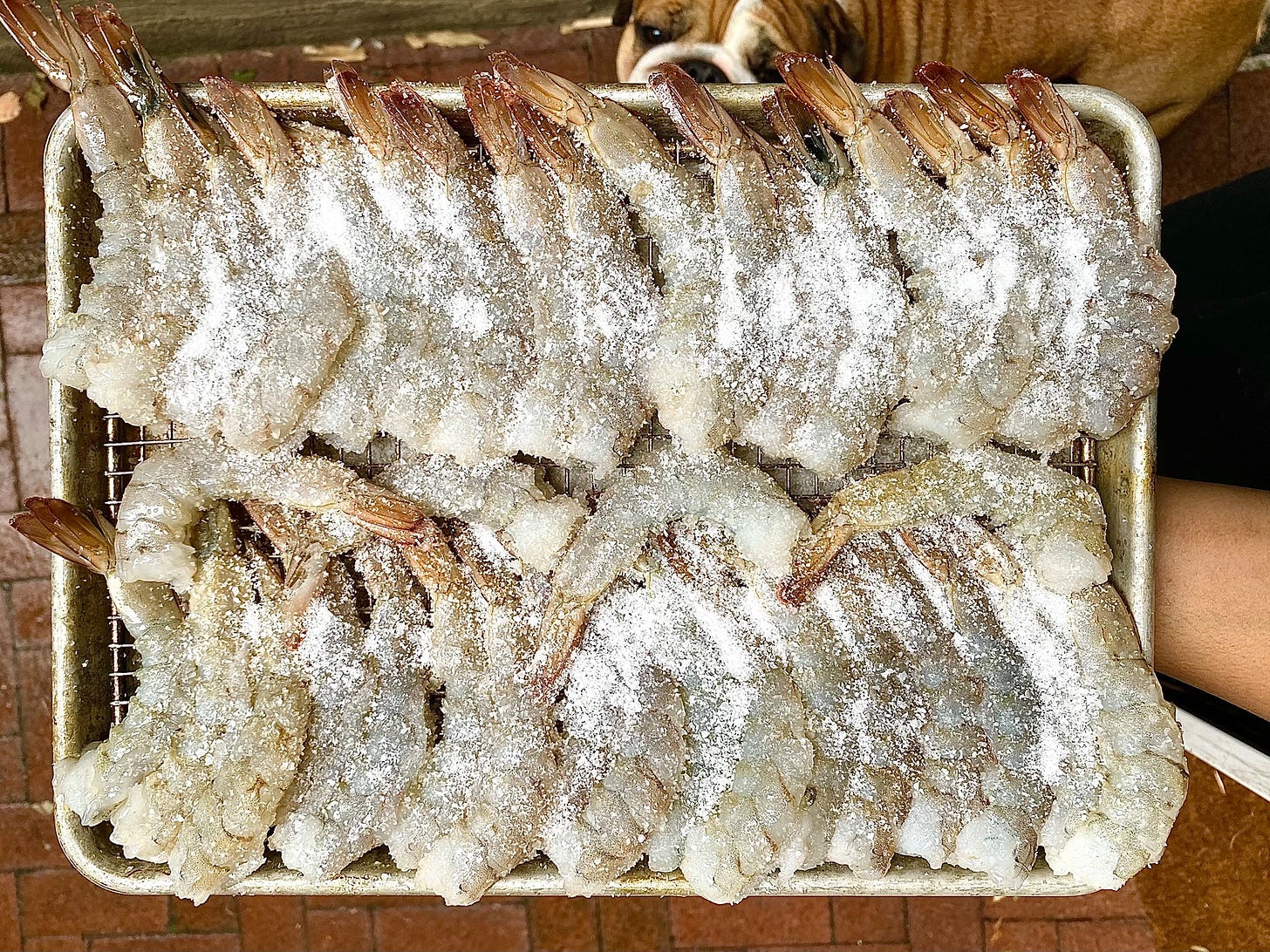

Discover more from Hot Dish with Sohla
Behold the Glory of Shrimp Cocktail!
So majestic! So regal! Nothing breaks the ice better than chilled and snappy shrimp! Yes, we need all these exclamation points!

It has the power to unite the room. Liven conversation. Salvage a stagnant gathering of marginally hostile acquaintances. The cold air in the room warms as every guest inevitably stops by the ornate bowl, clutches their chest, and shrieks, “Is that shrimp cocktail?!? I LOVE shrimp cocktail!” Its magnetism is undeniable.
For the unfamiliar, shrimp cocktail artfully rests chilled shrimp that have been delicately cooked until snappy, on the rim of a bowl or glass filled with a horseradish-spiked ketchup concoction known as cocktail sauce. Some say that shrimp cocktail really popped during the 1920s because Prohibition had a lot of fancy cocktail glasses gathering dust (at least in theory). Shrimp cocktail was the perfect way to fill them up.
Here’s how I like to make it:

Cocktail glasses are for suckers
Size Matters
You want a shrimp that is large enough to grab with your fingers, but not so large that you need to ponder a double dip. I like to go for U 16-20, which means there are 16 to 20 shrimp in a pound (the bigger the number, the smaller the shrimp). Depending on what else is on the menu, I aim for 4 to 6 shrimp per guest. I always stay away from pre-peeled shrimp because they are usually of lower quality and can cook up mealy.
Peel & Devein
Some people will lie to you and tell you that deveining shrimp is unnecessary. Not true—it’s very necessary. The vein isn’t a vein at all, but in fact the digestive tract of the shrimp. It’s technically safe to eat, but it’s gritty (and it’s technically poop). I peel shrimp by snipping up its back with a pair of scissors, pulling off the surrounding shell (but leaving the tail intact), and using the tip of the scissors to pull out the intestine. Make sure to save all your shrimp shells, as they’ll ramp up the flavor of the shrimp’s cooking liquid later on.
Dry Brine
Next comes the step that brings the magic: The dry brine. Dry brining is a process where something, usually a protein, is covered in salt and seasoning and left to rest. Dry brining accomplishes the same thing as a traditional water-based brine —seasoning and improving texture—without the worry of diluting flavor. I also find it more space efficient as it uses a rack and I don’t have room in my fridge for buckets of salty water every time I want to brine.

Spot the pooch
For every pound of shrimp, I mix 3 tablespoons of kosher salt with ½ teaspoon of baking soda. The salt seasons and tenderizes the shrimp, while the baking soda enhances that satisfying bouncy texture. I toss the shrimp in the mixture, then let it brine in the fridge arranged on a wire rack set into a sheet tray for 15 minutes. Next, I rinse them in cold water, pat them dry, and store them on a rack in the fridge until I am ready to cook. This is how I prepare shrimp for any cooking method, but especially for poaching.
Poach & Chill
Poaching isn’t just for eggs—it refers to anything gently cooked in seasoned water or liquid. I play it pretty chill with my poaching liquid, tossing in whatever citrus (juice and the spent fruit) and herbs I have around, along with the shrimp shells and plenty of kosher salt. I simmer everything for just ten minutes before straining the liquid and returning it to the pot. Then I taste it and adjust with more acid or salt as needed—it should be delicious on its own, like a flavorful shrimp soup.
When it’s time to poach, I heat the shrimp stock it to about 180F and add my shrimp. Precise temperature isn’t necessary; just be sure the liquid never comes to a boil. If the shrimp are poached aggressively, they can become rubbery and stringy. If they are started in cold liquid, they can become mealy.
I stir everything gently to make sure that the heat is evenly dispersed and start checking the shrimp for doneness as they begin to curl. When the shrimp are opaque in the center, I remove them from the pot. Then I halt the cooking by rinsing them under cold water and covering them with ice in a colander in the sink. Once fully chilled, I lay them flat in the fridge until the shrimp party begins. The shrimp and the sauce both need to be ice cold for maximum S.C. enjoyment.

Even blurry, she's cute
Get Lost in the Sauce
Sure the shrimp comes first in the name, but everybody knows shrimp cocktail is all about that tangy cocktail sauce. It’s just a seasoning game: A balancing act of umami, sweetness, acidity, and heat. I start with Heinz ketchup (accept no substitutions) for a sweet and salty base, then I turn up the flavor. For umami, I hit it with Red Boat fish sauce. Acidity comes from Tabasco and freshly squeezed lemon juice. Then it needs a big punch from finely grated garlic, prepared horseradish, and a hit of raw alcohol like brandy or whisky. The final shot of raw alcohol helps round out all the flavors and adds a pleasant burn. I add all my components and taste after each addition until I’m happy that everybody is bringing their best to the party. When I am finally content, I chill my cocktail sauce for at least one hour to make sure the flavors meld and that the sauce is nice and cold.
And now we eat.
There are few things better on a hot day than snappy, cold shrimp smothered in a sweet, zippy, spicy cocktail sauce. I am always at least three shrimp deep before I am done assembling the platter. And I always regret not buying more shrimp.
Happy shramping!
sohla
Subscribe to Hot Dish with Sohla
New exclusive recipes every month! Featuring fun tips on how to riff and deep dives into culinary techniques—so you can be a boss in your kitchen.










